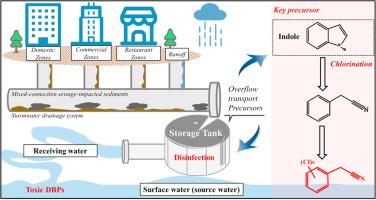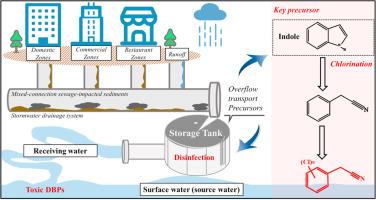Storm-driven overflow disinfection highlights toxicity risk of chlorophenylacetonitriles: Unveiling indole in sewer sediments as a key precursor
IF 12.4
1区 环境科学与生态学
Q1 ENGINEERING, ENVIRONMENTAL
引用次数: 0
Abstract
Storm-driven runoff scours accumulated sediments within stormwater drainage systems, transporting multi-source pollutants (including pathogens) into surface water through stormwater overflows, thereby elevating contamination risks in the recipient. Chlorine-based disinfection of overflowed stormwater applied in related storage tanks mitigates these risks before release. This study reveals that chlorophenylacetonitriles (CPANs), which are formed during the disinfection process, exhibit toxicity levels higher than conventional trihalomethanes and haloacetonitriles. Laboratory analyses conducted in this work demonstrated that sewer sediments — not runoff or stormwater — are the dominant precursor source for CPAN formation during overflow disinfection. Source apportionment further identified a robust linear correlation (R² = 0.95) between sediment indole concentrations (0.093–0.91 μg/g) and CPAN formation, experimentally confirming for the first time that indole is a critical precursor. Laboratory experiments also uncovered the presence of monochloroindoles in indole chlorination, a novel class of aromatic nitrogenous disinfection byproducts (DBPs). In addition, density functional theory calculations demonstrated that monochloroindole formation has lower activation energy barriers compared to CPAN pathways, resulting in new molecular-level insights into their preferential transformation. Given that indole serves as a shared precursor for both highly toxic CPANs and even more ecotoxic monochloroindoles, this study emphasizes the urgent need for sewer sediment management to mitigate the ecological and human health risks associated with these highly toxic nitrogenous DBPs.


暴雨驱动的溢流消毒凸显氯苯乙腈的毒性风险:揭示下水道沉积物中的吲哚是关键的前体
暴雨驱动的径流冲刷雨水排水系统内积累的沉积物,通过雨水溢流将多源污染物(包括病原体)输送到地表水中,从而增加了受污染地区的污染风险。在相关的储罐中对溢出的雨水进行氯基消毒,可以在排放之前减轻这些风险。本研究表明,在消毒过程中形成的氯苯乙腈(CPANs)的毒性水平高于传统的三卤甲烷和卤乙腈。在这项工作中进行的实验室分析表明,下水道沉积物-而不是径流或雨水-是溢流消毒过程中CPAN形成的主要前体来源。源解析进一步发现,沉积物中吲哚浓度(0.093 ~ 0.91 μg)与CPAN形成之间存在显著的线性相关(R² = 0.95),首次证实了吲哚是关键前体。实验室实验还发现在吲哚氯化中存在单氯吲哚,这是一类新的芳香氮消毒副产物(DBPs)。此外,密度泛函理论计算表明,与CPAN途径相比,单氯吲哚形成具有更低的活化能垒,从而对其优先转化有了新的分子水平的认识。鉴于吲哚是高毒性cpan和更具生态毒性的单氯吲哚的共同前体,本研究强调迫切需要对下水道沉积物进行管理,以减轻与这些高毒性含氮DBPs相关的生态和人类健康风险。
本文章由计算机程序翻译,如有差异,请以英文原文为准。
求助全文
约1分钟内获得全文
求助全文
来源期刊

Water Research
环境科学-工程:环境
CiteScore
20.80
自引率
9.40%
发文量
1307
审稿时长
38 days
期刊介绍:
Water Research, along with its open access companion journal Water Research X, serves as a platform for publishing original research papers covering various aspects of the science and technology related to the anthropogenic water cycle, water quality, and its management worldwide. The audience targeted by the journal comprises biologists, chemical engineers, chemists, civil engineers, environmental engineers, limnologists, and microbiologists. The scope of the journal include:
•Treatment processes for water and wastewaters (municipal, agricultural, industrial, and on-site treatment), including resource recovery and residuals management;
•Urban hydrology including sewer systems, stormwater management, and green infrastructure;
•Drinking water treatment and distribution;
•Potable and non-potable water reuse;
•Sanitation, public health, and risk assessment;
•Anaerobic digestion, solid and hazardous waste management, including source characterization and the effects and control of leachates and gaseous emissions;
•Contaminants (chemical, microbial, anthropogenic particles such as nanoparticles or microplastics) and related water quality sensing, monitoring, fate, and assessment;
•Anthropogenic impacts on inland, tidal, coastal and urban waters, focusing on surface and ground waters, and point and non-point sources of pollution;
•Environmental restoration, linked to surface water, groundwater and groundwater remediation;
•Analysis of the interfaces between sediments and water, and between water and atmosphere, focusing specifically on anthropogenic impacts;
•Mathematical modelling, systems analysis, machine learning, and beneficial use of big data related to the anthropogenic water cycle;
•Socio-economic, policy, and regulations studies.
 求助内容:
求助内容: 应助结果提醒方式:
应助结果提醒方式:


